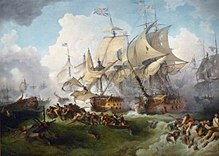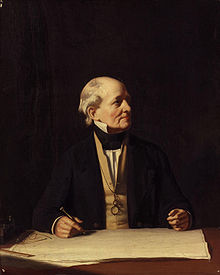Francis Beaufort
Sir Francis Beaufort (born May 7, 1774 in Navan , County Meath , in present-day Ireland , † December 17, 1857 in Hove , Sussex , England) was a hydrograph of the British Admiralty . In this function he was responsible for the Admiralty Charts , which were considered the best nautical charts in the world at the time . However , Beaufort only played a small part in the development of the wind scale ( Beaufort scale ), which was later named after him.
youth
Francis Beaufort was the third of seven children to a country minister. French was spoken in the house of the Huguenot family. The father was interested in many things: some of the churches that Daniel Augustus Beaufort (1739–1831) designed are still standing today. In 1792 he made the first topographical map of Ireland , which was printed in numerous editions; the young Francis contributed some longitude and latitude measurements. Towards the end of his life, Trinity College in Dublin awarded the father an honorary doctorate in law.

According to his sister, Francis is said to have decided to go to sea at the age of five. His father provided him with an astronomical training, which was considered necessary for seafaring, and in 1789 Francis Beaufort set sail at the age of fourteen as a cadet on a merchant ship of the East India Company . The Vansittart was supposed to measure a strait off Sumatra , where several of the company's ships had already sunk in poorly mapped shallows. But Beaufort's ship also went down here, and the crew had to take refuge on a reef off a tiny island in the Java Sea . She made her way to a Dutch settlement, where two British clippers took her on board. A year after his departure, Beaufort returned to England and joined the Navy. On " Glorious June 1st " 1794 he took part in the naval battle against the French fleet, was wounded by a saber while boarding a Spanish ship and hit in the face by a bullet.
The map of Montevideo and the survey of the Turkish south coast
Beaufort then temporarily commanded a ship himself, a captured French corvette . In 1806 he rose to captain the Woolwich , a supply ship that was supposed to deliver supplies to Buenos Aires , which had just been conquered by the Spanish ; however, the British troops had already withdrawn to Montevideo . Beaufort used the time to map the city itself and the coastal waters off Montevideo. The nautical chart was a model of clarity and was incorporated into the admiralty charts with practically no change . The quality of his Montevideo map made the Admiralty aware of Beaufort, in 1810 he was promoted to captain and was given command of the Frederiksteen , a captured Danish frigate .
In 1812 Beaufort was commissioned to survey the Turkish south coast, which was called "Karamanien" in Ottoman times. During this trip he made numerous views of the coast and ancient sites and copied hundreds of Greek inscriptions. The trip ended with an incident in which locals threatened the British sailors with muskets and Beaufort was shot in the hip. Beaufort used the time of his recovery to write the travelogue "Caramania or Description of the South Coast of Asia Minor", which found huge sales after its publication in 1817 and was also translated into German. Because he had been serving the Admiralty, he refused to accept payment for his book.
Admiralty hydrograph

In 1829, Beaufort was named the Admiralty's hydrograph (a hydrograph maps coastlines and plumbs waters). After the end of the Napoleonic Wars , the navy was used, among other things, to explore and measure the world's oceans. The Beagle's voyage of 1831, during which Darwin traveled around the world - incidentally through the agency of Beaufort - is just one example of this. It actually served to survey the South American coast.
In 1834, Beaufort's wife Alicia, with whom he had been married for more than twenty years, died of breast cancer. She left six children. The household was run by his unmarried sister Harriet for three years before Beaufort remarried. He encrypted his diaries and the correspondence with his brother partially with a modification of the Vigenère cipher . The coded parts deal, among other things, with sexual needs. 1848 Beaufort was of Queen Victoria as a Knight Commander of the Order of the Bath in the knighthood collected and allowed henceforth bear the name suffix "Sir". Most recently he held the rank of rear admiral .
Beaufort spent most of his last years in the Arctic Council of the Admiralty, which dealt with the search for the Northwest Passage . When after three years no sign of life came from the expedition of his personal friend Sir John Franklin , who had left with this assignment in 1845, he coordinated the various rescue expeditions . In 1854 Beaufort wanted to say goodbye, but because the Crimean War had begun, the Admiralty persuaded him to stay and deliver cards that were essential for the war effort. In 1855 he left the service for good.

In the same year, the survey of the British Isles, which Thomas Hurd (1747-1823) had started, was completed. In the 26 years in which Beaufort headed the Hydrographic Institute, it had produced 1,437 nautical charts in 113 surveying projects, so on average one map was published per week. The information was standardized during his tenure. The maps recorded tide heights and currents, buoys were noted in the form of small symbols, nautical miles became nautical miles, and the compass roses now indicated the cardinal points. From 1835 the five-thread line was marked and the depth was also given in feet. Beaufort took the view, which was remarkable for its time, that the place names of the locals - and not the terms of European explorers - should be used in the maps. Nevertheless, the Beaufort Sea off the north coast of Canada and Alaska and the Antarctic Beaufort Island are named after him.
The Beaufort wind scale
The Beaufort wind scale is not from Francis Beaufort. Probably in 1779 he got to know a simple wind scale from the then hydrograph of the "East India Company" and from 1795 first hydrograph of the Admiralty, Alexander Dalrymple , which ranged from 1 "weak draft" to 12 "storm". This scale already had much better developed models from the operation of windmills.
Throughout his life Beaufort kept an extensive diary in which he recorded the weather, among other things. On January 12 or 13, 1806, he entered the words: “From now on I will estimate the strength of the wind according to the following scale, because nothing gives a more unclear idea of wind and weather than the old expressions moderate and cloudy, etc. etc. “This is followed by a scale from 1 to 13, which ranges from“ calm ”to“ storm ”. On September 14, 1807 he started a new diary in which - as usual - he noted the wind scale on the flyleaf that he intended to use. Shortly afterwards, he improved the scale by adding how the wind force could be seen on the sails of a fully rigged frigate. For example, wind force 5 prevails when topsail , slab sails , royal, aviator and staysail can remain hoisted, with wind force 7 the three top sails must be reefed.
After Beaufort became the Admiralty's hydrograph in 1829, he passed his improved scale on to anyone interested. It was published in the Admiralty's Nautical Magazine in 1832 . In 1837 the scale was already in use throughout the surveying service, and at the end of 1838 the Admiralty issued an instruction making it mandatory. However, this scale had no name and was simply referred to as the "attached scheme". Even in the detailed obituaries on the occasion of Beaufort's death, a wind force scale is never mentioned. It wasn't until 1906 that the British Weather Service created the version of the scale that has come to be known as the Beaufort scale.
The estate is in the Huntington Library , San Marino , California.
Works
-
Karamania, or a brief description of the south coast of Asia-Minor and of the remains of antiquity: with plans, views, & c .; collected during a survey of that coast, under the orders of the lords commissioners of the admiralty, in the years 1811 & 1812 . London 1817. 2nd edition 1818. on GoogleBooks
- German: Karamanien or description of the south coast of Asia Minor . Weimar 1821 Internet publication
- Memoir of a survey of the coast of Karamania: made ... in 1811 & 1812 . London 1821.
literature
- Nicholas Courtney: Gale Force Ten. The life and legacy of Admiral Beaufort, 1774-1857 . Review Publ., London 2002, ISBN 0-7472-6485-6 .
- Alfred Friendly: Beaufort of the Admiralty. The Life of Sir Francis Beaufort 1774-1857 . Random House, New York 1977, ISBN 0-394-41760-7 .
- Scott Huler: The Language of the Wind. How a 19th century admiral transformed science into poetry ("Defining the wind"). mareverlag, Hamburg 2009, ISBN 978-3-86648-114-5 .
- Alfred Webb: Beaufort, Sir Francis . In: A Compendium of Irish Biography , MH Gill & Son, Sackville-Street. Dublin 1878 ( Wikisource , English)
Web links
- Entry to Beaufort; Sir; Francis (1774-1857); Knight Rear Admiral Hydrographer in the Royal Society Archives , London
- Rear Adm. Sir Francis Beaufort, on thepeerage.com , accessed September 11, 2016.
References and comments
- ↑ Navan z. B. According to Irish Biography , The Peerage names County Louth as the place of birth and May 27, 1774 as the birthday. The Royal Society and Irish Biography only mention the year of birth 1774.
- ↑ December 17th z. B. according to Royal Society , Irish Biography deviates December 16.
| personal data | |
|---|---|
| SURNAME | Beaufort, Francis |
| BRIEF DESCRIPTION | British admiral |
| DATE OF BIRTH | May 7, 1774 |
| PLACE OF BIRTH | Navan |
| DATE OF DEATH | December 17, 1857 |
| Place of death | Hove |

